Arts Council England: Managing Organizational Culture and Change
VerifiedAdded on 2023/04/25
|11
|3428
|342
Essay
AI Summary
This essay examines organizational culture and change management, focusing on the Arts Council England case study. The essay explores how the organization worked on its culture to support partnership working, addressing the organization's background, drivers of change, key activities, change agents' and staff reflections, and the impact of the cultural shift. It delves into the materialization of cultural levels (artifacts, espoused beliefs, and underlying assumptions) and the role of media (structure, process, and participation) in driving organizational change. The analysis highlights how these elements contribute to a collaborative working model and sustainable performance. The essay provides insights into the complexities of cultural transformation and the strategies employed by Arts Council England to improve its operations and future prospects, including the importance of transparency, communication, and employee involvement in fostering a new cultural environment.
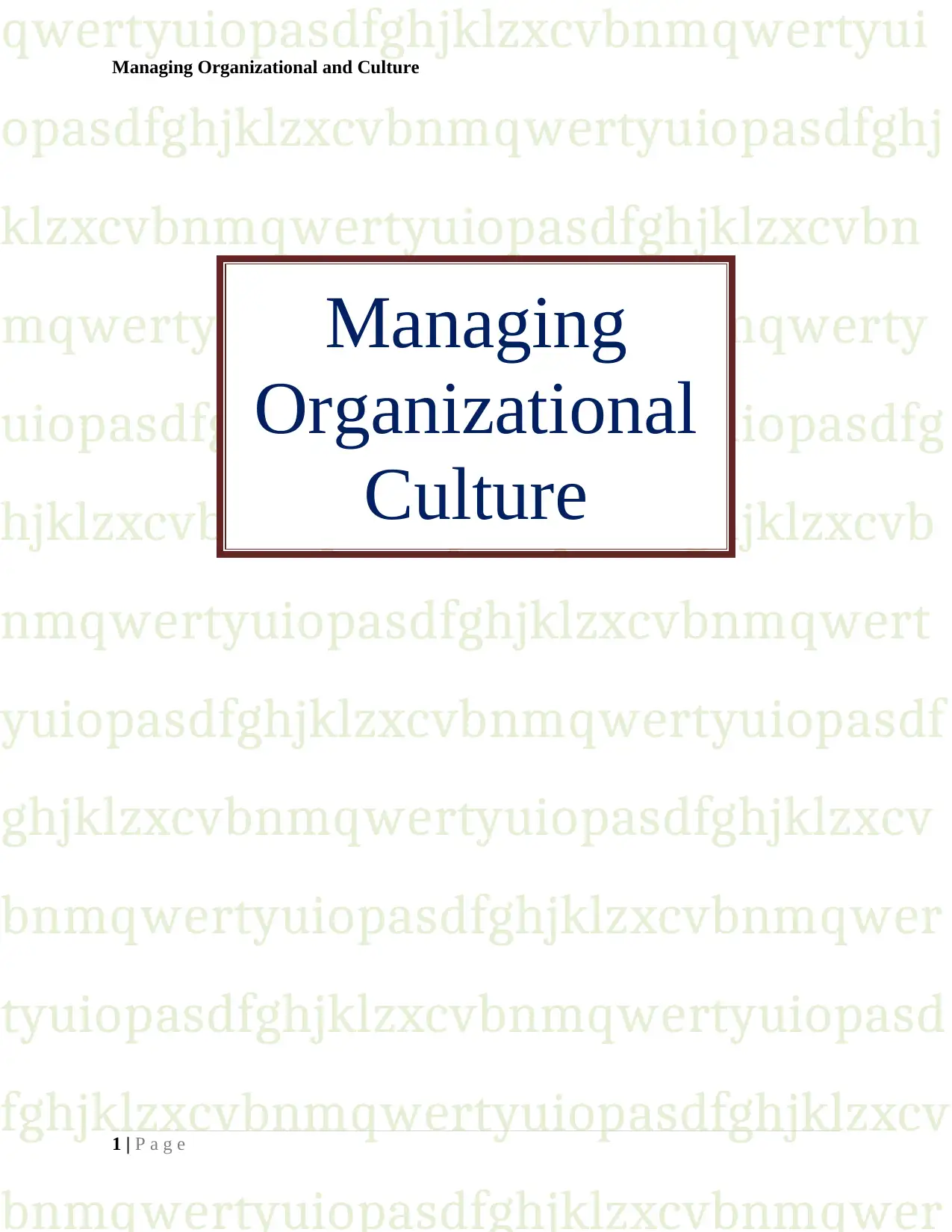
qwertyuiopasdfghjklzxcvbnmqwertyui
opasdfghjklzxcvbnmqwertyuiopasdfghj
klzxcvbnmqwertyuiopasdfghjklzxcvbn
mqwertyuiopasdfghjklzxcvbnmqwerty
uiopasdfghjklzxcvbnmqwertyuiopasdfg
hjklzxcvbnmqwertyuiopasdfghjklzxcvb
nmqwertyuiopasdfghjklzxcvbnmqwert
yuiopasdfghjklzxcvbnmqwertyuiopasdf
ghjklzxcvbnmqwertyuiopasdfghjklzxcv
bnmqwertyuiopasdfghjklzxcvbnmqwer
tyuiopasdfghjklzxcvbnmqwertyuiopasd
fghjklzxcvbnmqwertyuiopasdfghjklzxcv
bnmqwertyuiopasdfghjklzxcvbnmqwer
Managing Organizational and Culture
Managing
Organizational
Culture
1 | P a g e
opasdfghjklzxcvbnmqwertyuiopasdfghj
klzxcvbnmqwertyuiopasdfghjklzxcvbn
mqwertyuiopasdfghjklzxcvbnmqwerty
uiopasdfghjklzxcvbnmqwertyuiopasdfg
hjklzxcvbnmqwertyuiopasdfghjklzxcvb
nmqwertyuiopasdfghjklzxcvbnmqwert
yuiopasdfghjklzxcvbnmqwertyuiopasdf
ghjklzxcvbnmqwertyuiopasdfghjklzxcv
bnmqwertyuiopasdfghjklzxcvbnmqwer
tyuiopasdfghjklzxcvbnmqwertyuiopasd
fghjklzxcvbnmqwertyuiopasdfghjklzxcv
bnmqwertyuiopasdfghjklzxcvbnmqwer
Managing Organizational and Culture
Managing
Organizational
Culture
1 | P a g e
Paraphrase This Document
Need a fresh take? Get an instant paraphrase of this document with our AI Paraphraser
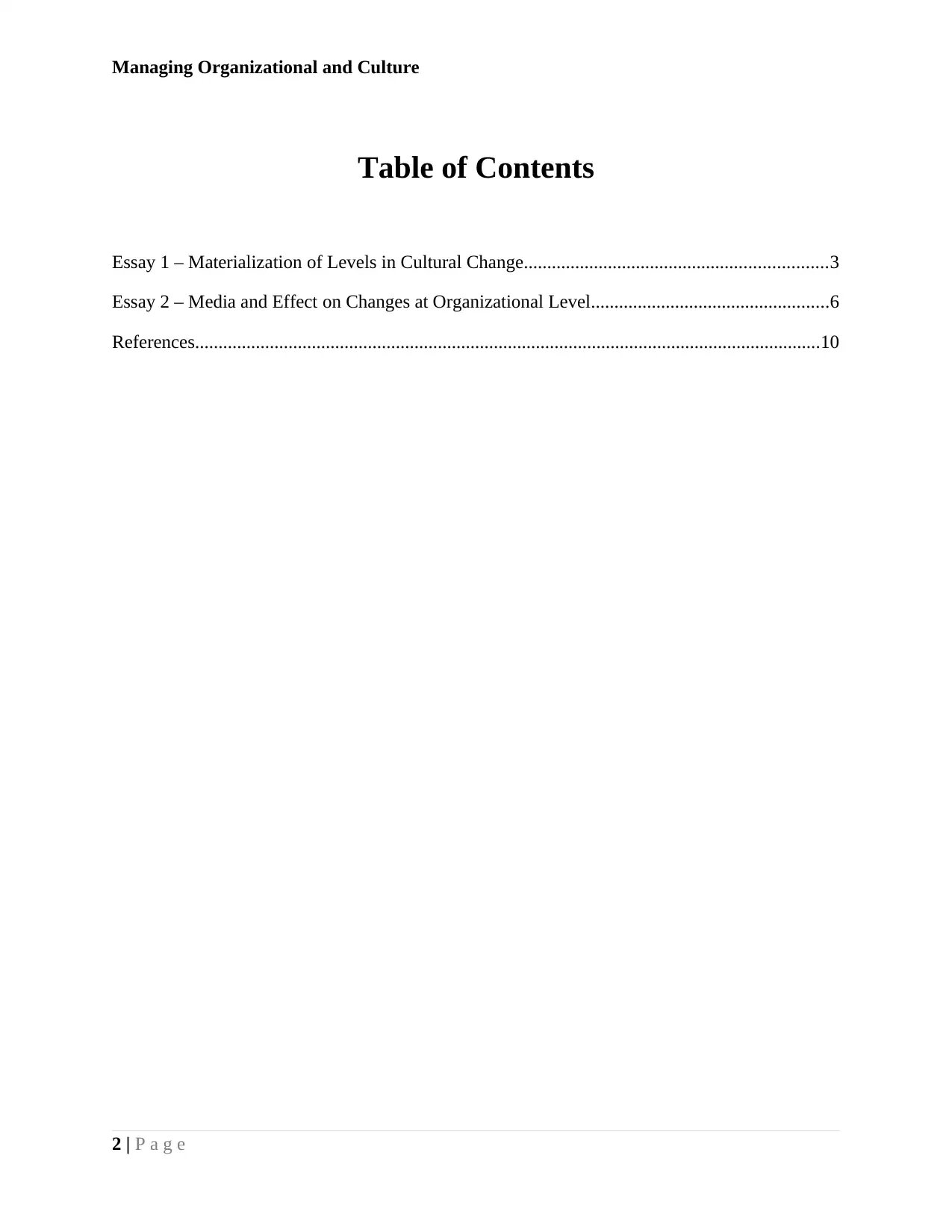
Managing Organizational and Culture
Table of Contents
Essay 1 – Materialization of Levels in Cultural Change.................................................................3
Essay 2 – Media and Effect on Changes at Organizational Level...................................................6
References......................................................................................................................................10
2 | P a g e
Table of Contents
Essay 1 – Materialization of Levels in Cultural Change.................................................................3
Essay 2 – Media and Effect on Changes at Organizational Level...................................................6
References......................................................................................................................................10
2 | P a g e
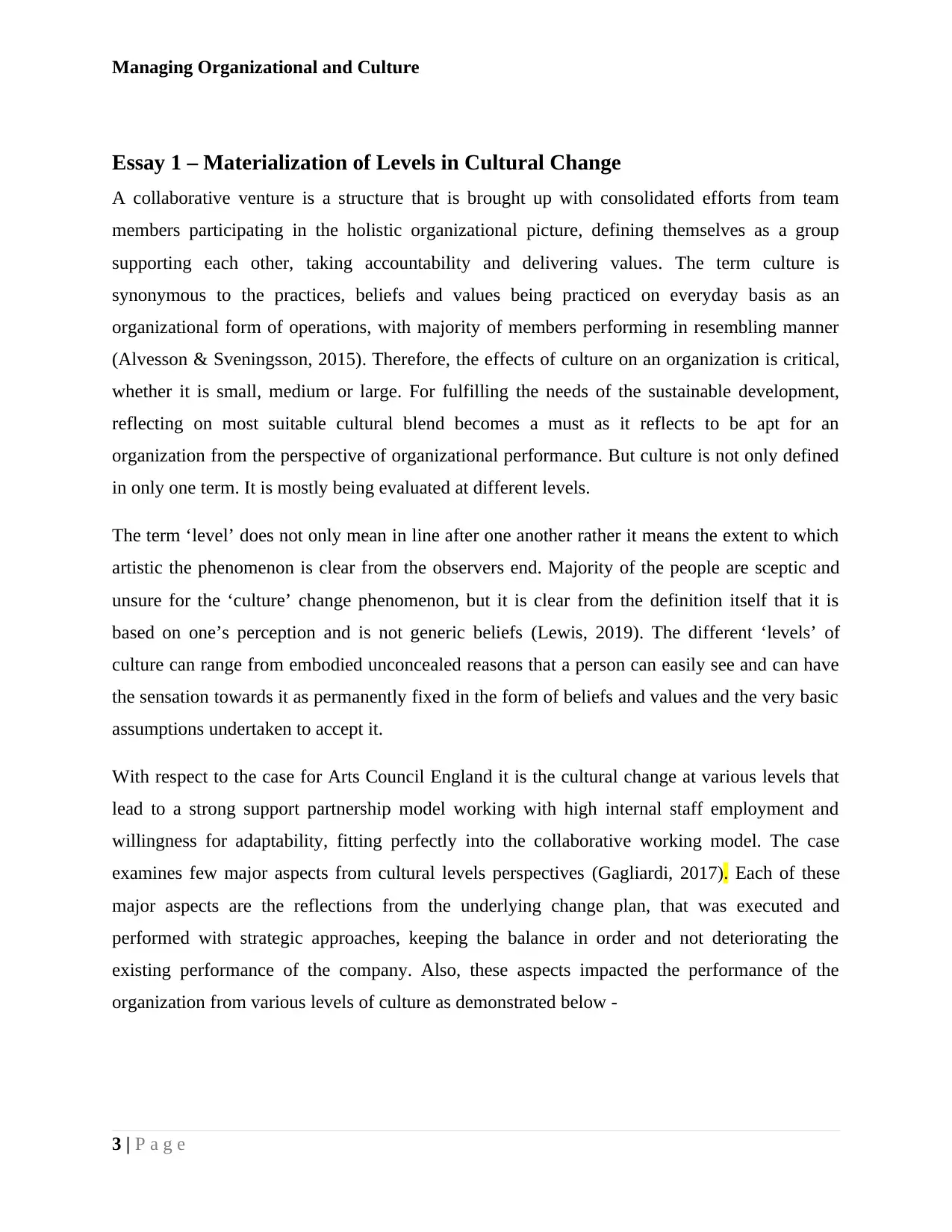
Managing Organizational and Culture
Essay 1 – Materialization of Levels in Cultural Change
A collaborative venture is a structure that is brought up with consolidated efforts from team
members participating in the holistic organizational picture, defining themselves as a group
supporting each other, taking accountability and delivering values. The term culture is
synonymous to the practices, beliefs and values being practiced on everyday basis as an
organizational form of operations, with majority of members performing in resembling manner
(Alvesson & Sveningsson, 2015). Therefore, the effects of culture on an organization is critical,
whether it is small, medium or large. For fulfilling the needs of the sustainable development,
reflecting on most suitable cultural blend becomes a must as it reflects to be apt for an
organization from the perspective of organizational performance. But culture is not only defined
in only one term. It is mostly being evaluated at different levels.
The term ‘level’ does not only mean in line after one another rather it means the extent to which
artistic the phenomenon is clear from the observers end. Majority of the people are sceptic and
unsure for the ‘culture’ change phenomenon, but it is clear from the definition itself that it is
based on one’s perception and is not generic beliefs (Lewis, 2019). The different ‘levels’ of
culture can range from embodied unconcealed reasons that a person can easily see and can have
the sensation towards it as permanently fixed in the form of beliefs and values and the very basic
assumptions undertaken to accept it.
With respect to the case for Arts Council England it is the cultural change at various levels that
lead to a strong support partnership model working with high internal staff employment and
willingness for adaptability, fitting perfectly into the collaborative working model. The case
examines few major aspects from cultural levels perspectives (Gagliardi, 2017). Each of these
major aspects are the reflections from the underlying change plan, that was executed and
performed with strategic approaches, keeping the balance in order and not deteriorating the
existing performance of the company. Also, these aspects impacted the performance of the
organization from various levels of culture as demonstrated below -
3 | P a g e
Essay 1 – Materialization of Levels in Cultural Change
A collaborative venture is a structure that is brought up with consolidated efforts from team
members participating in the holistic organizational picture, defining themselves as a group
supporting each other, taking accountability and delivering values. The term culture is
synonymous to the practices, beliefs and values being practiced on everyday basis as an
organizational form of operations, with majority of members performing in resembling manner
(Alvesson & Sveningsson, 2015). Therefore, the effects of culture on an organization is critical,
whether it is small, medium or large. For fulfilling the needs of the sustainable development,
reflecting on most suitable cultural blend becomes a must as it reflects to be apt for an
organization from the perspective of organizational performance. But culture is not only defined
in only one term. It is mostly being evaluated at different levels.
The term ‘level’ does not only mean in line after one another rather it means the extent to which
artistic the phenomenon is clear from the observers end. Majority of the people are sceptic and
unsure for the ‘culture’ change phenomenon, but it is clear from the definition itself that it is
based on one’s perception and is not generic beliefs (Lewis, 2019). The different ‘levels’ of
culture can range from embodied unconcealed reasons that a person can easily see and can have
the sensation towards it as permanently fixed in the form of beliefs and values and the very basic
assumptions undertaken to accept it.
With respect to the case for Arts Council England it is the cultural change at various levels that
lead to a strong support partnership model working with high internal staff employment and
willingness for adaptability, fitting perfectly into the collaborative working model. The case
examines few major aspects from cultural levels perspectives (Gagliardi, 2017). Each of these
major aspects are the reflections from the underlying change plan, that was executed and
performed with strategic approaches, keeping the balance in order and not deteriorating the
existing performance of the company. Also, these aspects impacted the performance of the
organization from various levels of culture as demonstrated below -
3 | P a g e
⊘ This is a preview!⊘
Do you want full access?
Subscribe today to unlock all pages.

Trusted by 1+ million students worldwide
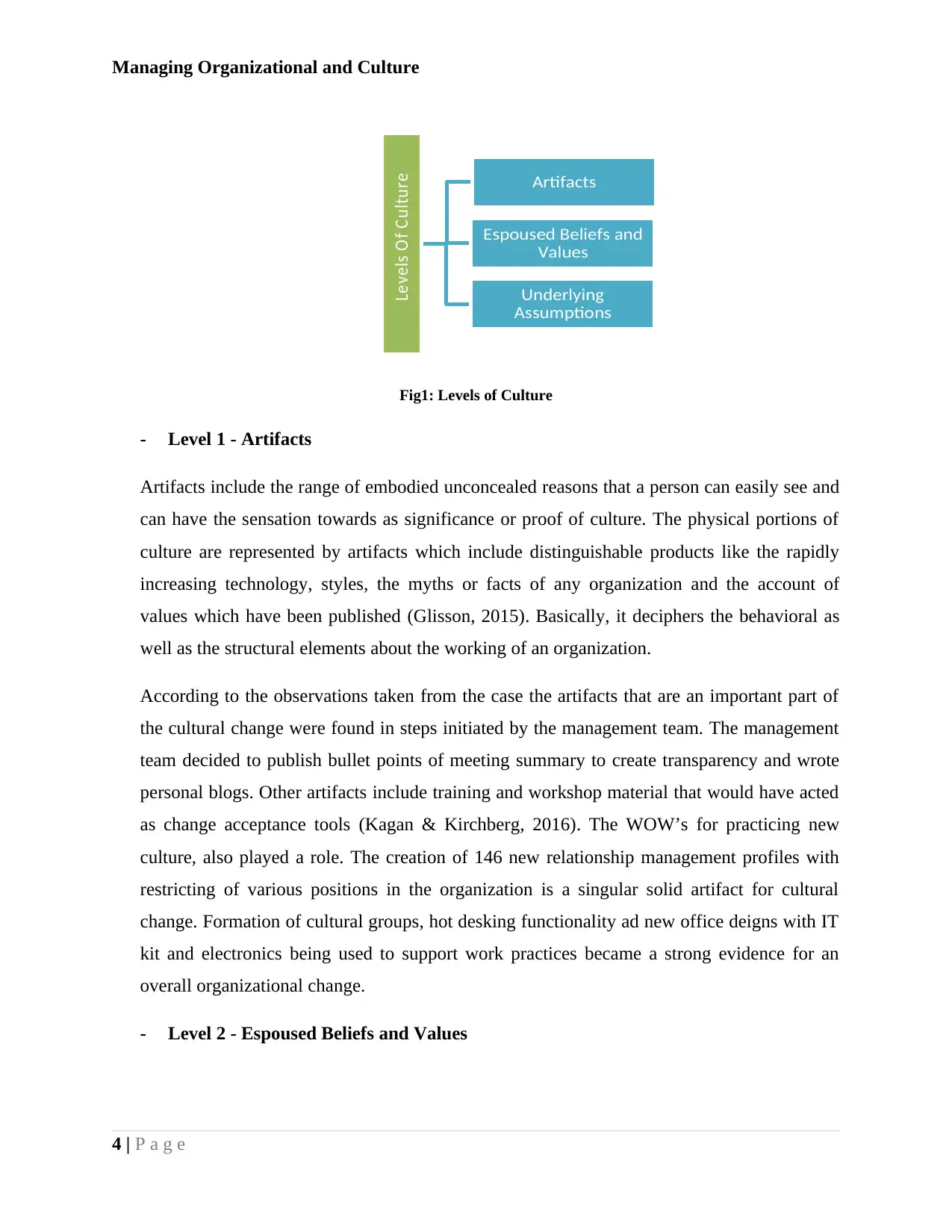
Managing Organizational and Culture
Fig1: Levels of Culture
- Level 1 - Artifacts
Artifacts include the range of embodied unconcealed reasons that a person can easily see and
can have the sensation towards as significance or proof of culture. The physical portions of
culture are represented by artifacts which include distinguishable products like the rapidly
increasing technology, styles, the myths or facts of any organization and the account of
values which have been published (Glisson, 2015). Basically, it deciphers the behavioral as
well as the structural elements about the working of an organization.
According to the observations taken from the case the artifacts that are an important part of
the cultural change were found in steps initiated by the management team. The management
team decided to publish bullet points of meeting summary to create transparency and wrote
personal blogs. Other artifacts include training and workshop material that would have acted
as change acceptance tools (Kagan & Kirchberg, 2016). The WOW’s for practicing new
culture, also played a role. The creation of 146 new relationship management profiles with
restricting of various positions in the organization is a singular solid artifact for cultural
change. Formation of cultural groups, hot desking functionality ad new office deigns with IT
kit and electronics being used to support work practices became a strong evidence for an
overall organizational change.
- Level 2 - Espoused Beliefs and Values
4 | P a g e
Levels Of Culture Artifacts
Espoused Beliefs and
Values
Underlying
Assumptions
Fig1: Levels of Culture
- Level 1 - Artifacts
Artifacts include the range of embodied unconcealed reasons that a person can easily see and
can have the sensation towards as significance or proof of culture. The physical portions of
culture are represented by artifacts which include distinguishable products like the rapidly
increasing technology, styles, the myths or facts of any organization and the account of
values which have been published (Glisson, 2015). Basically, it deciphers the behavioral as
well as the structural elements about the working of an organization.
According to the observations taken from the case the artifacts that are an important part of
the cultural change were found in steps initiated by the management team. The management
team decided to publish bullet points of meeting summary to create transparency and wrote
personal blogs. Other artifacts include training and workshop material that would have acted
as change acceptance tools (Kagan & Kirchberg, 2016). The WOW’s for practicing new
culture, also played a role. The creation of 146 new relationship management profiles with
restricting of various positions in the organization is a singular solid artifact for cultural
change. Formation of cultural groups, hot desking functionality ad new office deigns with IT
kit and electronics being used to support work practices became a strong evidence for an
overall organizational change.
- Level 2 - Espoused Beliefs and Values
4 | P a g e
Levels Of Culture Artifacts
Espoused Beliefs and
Values
Underlying
Assumptions
Paraphrase This Document
Need a fresh take? Get an instant paraphrase of this document with our AI Paraphraser
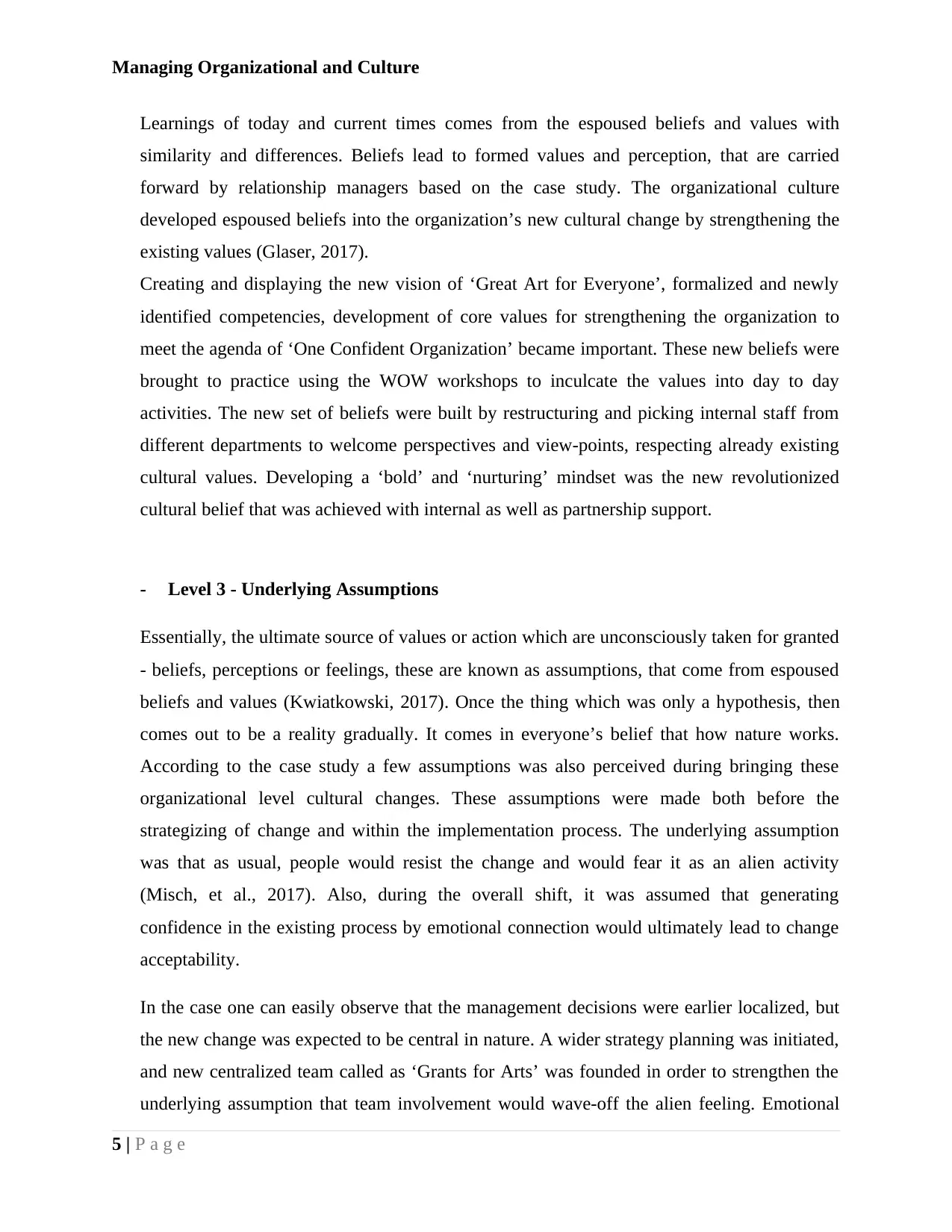
Managing Organizational and Culture
Learnings of today and current times comes from the espoused beliefs and values with
similarity and differences. Beliefs lead to formed values and perception, that are carried
forward by relationship managers based on the case study. The organizational culture
developed espoused beliefs into the organization’s new cultural change by strengthening the
existing values (Glaser, 2017).
Creating and displaying the new vision of ‘Great Art for Everyone’, formalized and newly
identified competencies, development of core values for strengthening the organization to
meet the agenda of ‘One Confident Organization’ became important. These new beliefs were
brought to practice using the WOW workshops to inculcate the values into day to day
activities. The new set of beliefs were built by restructuring and picking internal staff from
different departments to welcome perspectives and view-points, respecting already existing
cultural values. Developing a ‘bold’ and ‘nurturing’ mindset was the new revolutionized
cultural belief that was achieved with internal as well as partnership support.
- Level 3 - Underlying Assumptions
Essentially, the ultimate source of values or action which are unconsciously taken for granted
- beliefs, perceptions or feelings, these are known as assumptions, that come from espoused
beliefs and values (Kwiatkowski, 2017). Once the thing which was only a hypothesis, then
comes out to be a reality gradually. It comes in everyone’s belief that how nature works.
According to the case study a few assumptions was also perceived during bringing these
organizational level cultural changes. These assumptions were made both before the
strategizing of change and within the implementation process. The underlying assumption
was that as usual, people would resist the change and would fear it as an alien activity
(Misch, et al., 2017). Also, during the overall shift, it was assumed that generating
confidence in the existing process by emotional connection would ultimately lead to change
acceptability.
In the case one can easily observe that the management decisions were earlier localized, but
the new change was expected to be central in nature. A wider strategy planning was initiated,
and new centralized team called as ‘Grants for Arts’ was founded in order to strengthen the
underlying assumption that team involvement would wave-off the alien feeling. Emotional
5 | P a g e
Learnings of today and current times comes from the espoused beliefs and values with
similarity and differences. Beliefs lead to formed values and perception, that are carried
forward by relationship managers based on the case study. The organizational culture
developed espoused beliefs into the organization’s new cultural change by strengthening the
existing values (Glaser, 2017).
Creating and displaying the new vision of ‘Great Art for Everyone’, formalized and newly
identified competencies, development of core values for strengthening the organization to
meet the agenda of ‘One Confident Organization’ became important. These new beliefs were
brought to practice using the WOW workshops to inculcate the values into day to day
activities. The new set of beliefs were built by restructuring and picking internal staff from
different departments to welcome perspectives and view-points, respecting already existing
cultural values. Developing a ‘bold’ and ‘nurturing’ mindset was the new revolutionized
cultural belief that was achieved with internal as well as partnership support.
- Level 3 - Underlying Assumptions
Essentially, the ultimate source of values or action which are unconsciously taken for granted
- beliefs, perceptions or feelings, these are known as assumptions, that come from espoused
beliefs and values (Kwiatkowski, 2017). Once the thing which was only a hypothesis, then
comes out to be a reality gradually. It comes in everyone’s belief that how nature works.
According to the case study a few assumptions was also perceived during bringing these
organizational level cultural changes. These assumptions were made both before the
strategizing of change and within the implementation process. The underlying assumption
was that as usual, people would resist the change and would fear it as an alien activity
(Misch, et al., 2017). Also, during the overall shift, it was assumed that generating
confidence in the existing process by emotional connection would ultimately lead to change
acceptability.
In the case one can easily observe that the management decisions were earlier localized, but
the new change was expected to be central in nature. A wider strategy planning was initiated,
and new centralized team called as ‘Grants for Arts’ was founded in order to strengthen the
underlying assumption that team involvement would wave-off the alien feeling. Emotional
5 | P a g e
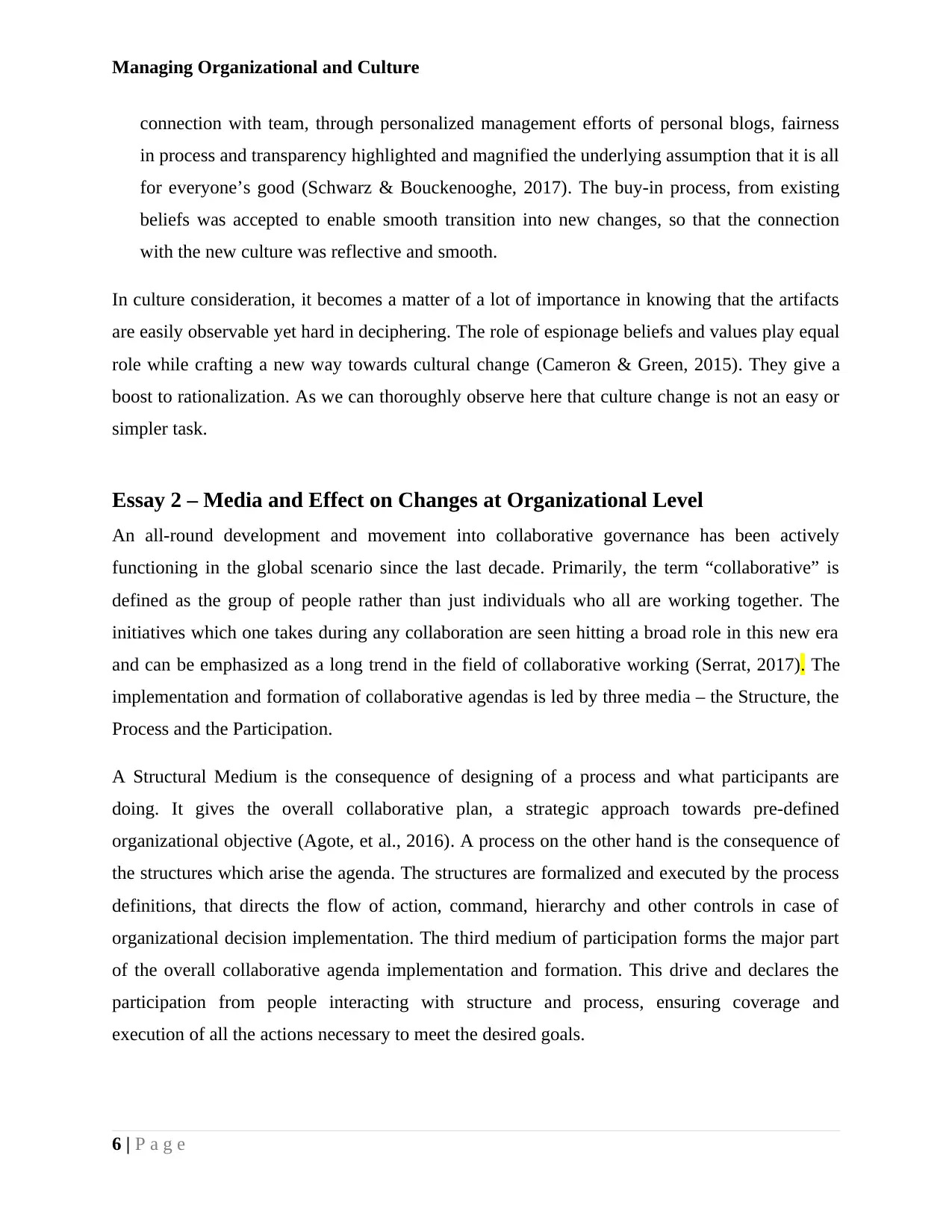
Managing Organizational and Culture
connection with team, through personalized management efforts of personal blogs, fairness
in process and transparency highlighted and magnified the underlying assumption that it is all
for everyone’s good (Schwarz & Bouckenooghe, 2017). The buy-in process, from existing
beliefs was accepted to enable smooth transition into new changes, so that the connection
with the new culture was reflective and smooth.
In culture consideration, it becomes a matter of a lot of importance in knowing that the artifacts
are easily observable yet hard in deciphering. The role of espionage beliefs and values play equal
role while crafting a new way towards cultural change (Cameron & Green, 2015). They give a
boost to rationalization. As we can thoroughly observe here that culture change is not an easy or
simpler task.
Essay 2 – Media and Effect on Changes at Organizational Level
An all-round development and movement into collaborative governance has been actively
functioning in the global scenario since the last decade. Primarily, the term “collaborative” is
defined as the group of people rather than just individuals who all are working together. The
initiatives which one takes during any collaboration are seen hitting a broad role in this new era
and can be emphasized as a long trend in the field of collaborative working (Serrat, 2017). The
implementation and formation of collaborative agendas is led by three media – the Structure, the
Process and the Participation.
A Structural Medium is the consequence of designing of a process and what participants are
doing. It gives the overall collaborative plan, a strategic approach towards pre-defined
organizational objective (Agote, et al., 2016). A process on the other hand is the consequence of
the structures which arise the agenda. The structures are formalized and executed by the process
definitions, that directs the flow of action, command, hierarchy and other controls in case of
organizational decision implementation. The third medium of participation forms the major part
of the overall collaborative agenda implementation and formation. This drive and declares the
participation from people interacting with structure and process, ensuring coverage and
execution of all the actions necessary to meet the desired goals.
6 | P a g e
connection with team, through personalized management efforts of personal blogs, fairness
in process and transparency highlighted and magnified the underlying assumption that it is all
for everyone’s good (Schwarz & Bouckenooghe, 2017). The buy-in process, from existing
beliefs was accepted to enable smooth transition into new changes, so that the connection
with the new culture was reflective and smooth.
In culture consideration, it becomes a matter of a lot of importance in knowing that the artifacts
are easily observable yet hard in deciphering. The role of espionage beliefs and values play equal
role while crafting a new way towards cultural change (Cameron & Green, 2015). They give a
boost to rationalization. As we can thoroughly observe here that culture change is not an easy or
simpler task.
Essay 2 – Media and Effect on Changes at Organizational Level
An all-round development and movement into collaborative governance has been actively
functioning in the global scenario since the last decade. Primarily, the term “collaborative” is
defined as the group of people rather than just individuals who all are working together. The
initiatives which one takes during any collaboration are seen hitting a broad role in this new era
and can be emphasized as a long trend in the field of collaborative working (Serrat, 2017). The
implementation and formation of collaborative agendas is led by three media – the Structure, the
Process and the Participation.
A Structural Medium is the consequence of designing of a process and what participants are
doing. It gives the overall collaborative plan, a strategic approach towards pre-defined
organizational objective (Agote, et al., 2016). A process on the other hand is the consequence of
the structures which arise the agenda. The structures are formalized and executed by the process
definitions, that directs the flow of action, command, hierarchy and other controls in case of
organizational decision implementation. The third medium of participation forms the major part
of the overall collaborative agenda implementation and formation. This drive and declares the
participation from people interacting with structure and process, ensuring coverage and
execution of all the actions necessary to meet the desired goals.
6 | P a g e
⊘ This is a preview!⊘
Do you want full access?
Subscribe today to unlock all pages.

Trusted by 1+ million students worldwide
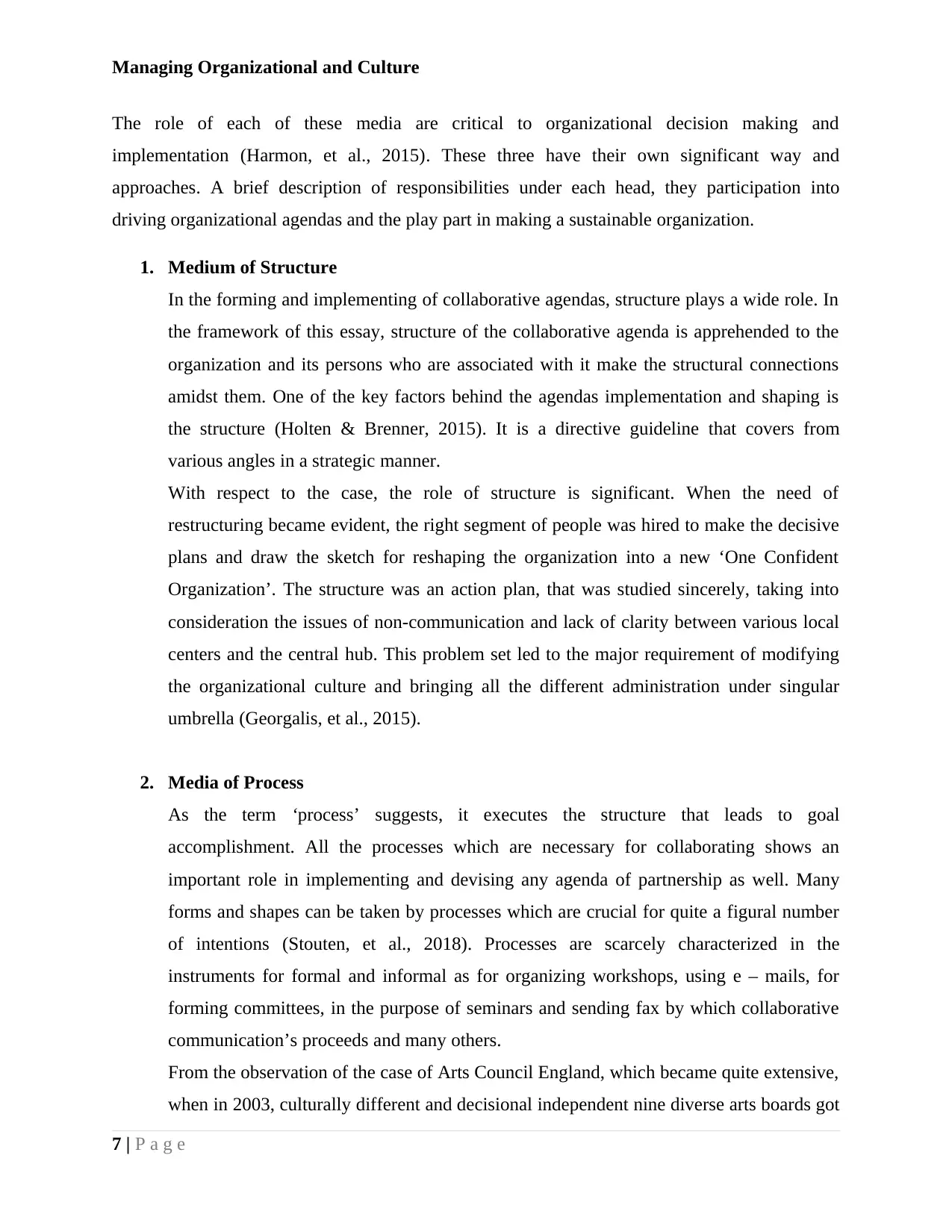
Managing Organizational and Culture
The role of each of these media are critical to organizational decision making and
implementation (Harmon, et al., 2015). These three have their own significant way and
approaches. A brief description of responsibilities under each head, they participation into
driving organizational agendas and the play part in making a sustainable organization.
1. Medium of Structure
In the forming and implementing of collaborative agendas, structure plays a wide role. In
the framework of this essay, structure of the collaborative agenda is apprehended to the
organization and its persons who are associated with it make the structural connections
amidst them. One of the key factors behind the agendas implementation and shaping is
the structure (Holten & Brenner, 2015). It is a directive guideline that covers from
various angles in a strategic manner.
With respect to the case, the role of structure is significant. When the need of
restructuring became evident, the right segment of people was hired to make the decisive
plans and draw the sketch for reshaping the organization into a new ‘One Confident
Organization’. The structure was an action plan, that was studied sincerely, taking into
consideration the issues of non-communication and lack of clarity between various local
centers and the central hub. This problem set led to the major requirement of modifying
the organizational culture and bringing all the different administration under singular
umbrella (Georgalis, et al., 2015).
2. Media of Process
As the term ‘process’ suggests, it executes the structure that leads to goal
accomplishment. All the processes which are necessary for collaborating shows an
important role in implementing and devising any agenda of partnership as well. Many
forms and shapes can be taken by processes which are crucial for quite a figural number
of intentions (Stouten, et al., 2018). Processes are scarcely characterized in the
instruments for formal and informal as for organizing workshops, using e – mails, for
forming committees, in the purpose of seminars and sending fax by which collaborative
communication’s proceeds and many others.
From the observation of the case of Arts Council England, which became quite extensive,
when in 2003, culturally different and decisional independent nine diverse arts boards got
7 | P a g e
The role of each of these media are critical to organizational decision making and
implementation (Harmon, et al., 2015). These three have their own significant way and
approaches. A brief description of responsibilities under each head, they participation into
driving organizational agendas and the play part in making a sustainable organization.
1. Medium of Structure
In the forming and implementing of collaborative agendas, structure plays a wide role. In
the framework of this essay, structure of the collaborative agenda is apprehended to the
organization and its persons who are associated with it make the structural connections
amidst them. One of the key factors behind the agendas implementation and shaping is
the structure (Holten & Brenner, 2015). It is a directive guideline that covers from
various angles in a strategic manner.
With respect to the case, the role of structure is significant. When the need of
restructuring became evident, the right segment of people was hired to make the decisive
plans and draw the sketch for reshaping the organization into a new ‘One Confident
Organization’. The structure was an action plan, that was studied sincerely, taking into
consideration the issues of non-communication and lack of clarity between various local
centers and the central hub. This problem set led to the major requirement of modifying
the organizational culture and bringing all the different administration under singular
umbrella (Georgalis, et al., 2015).
2. Media of Process
As the term ‘process’ suggests, it executes the structure that leads to goal
accomplishment. All the processes which are necessary for collaborating shows an
important role in implementing and devising any agenda of partnership as well. Many
forms and shapes can be taken by processes which are crucial for quite a figural number
of intentions (Stouten, et al., 2018). Processes are scarcely characterized in the
instruments for formal and informal as for organizing workshops, using e – mails, for
forming committees, in the purpose of seminars and sending fax by which collaborative
communication’s proceeds and many others.
From the observation of the case of Arts Council England, which became quite extensive,
when in 2003, culturally different and decisional independent nine diverse arts boards got
7 | P a g e
Paraphrase This Document
Need a fresh take? Get an instant paraphrase of this document with our AI Paraphraser

Managing Organizational and Culture
merged together. Each of the area was running on its own operations, following separate
processes and decision trees. A merger of these accomplished a singular arts entity in the
country but the blend of diversity did not mix very well. The need of organizational
cultural change arose, and the new set of strategic plans came into execution, giving the
process an important role in the new reformed organization (Bellou, et al., 2018). Various
processes to maintain transparency were introduced. The ideas of ‘Great Art for
Everyone’ came up as the vision that was accomplished by procedural changes of
centralization of decision making. The process became top-to-bottom in hierarchy
thereby bringing singular reforms into place to meet the change necessity. The workshop
processes for practice also termed as ‘WOW’ in the case is also a procedural initiative to
meet the sustainable agendas.
3. Media of Participation
The media of participants results from the influence of the two i.e. both the structure and
the process. The most powerful leadership role in influencing the agendas are played by
the medium of participant. Participants are predominantly defined as organizations,
groups or individuals who play active role in bringing the designated change.
Participation can come from internal and external human resource elements that can act
as key executor of structural processes (Petrou, et al., 2018). The internal participants can
be team members, management and stakeholders, whereas external participation comes
from third parties, partner organizations or externally associated groups.
With reference to the case of Arts Council England, the participation of people is what
led to the organizational level change in such an enormous form. The selection for right
people to develop the change plan, the right participation of management, the willingness
of change agents to reform the culture and the participation in the workshops to indulge
into changing necessities to meet the organizational standard is what this crucial medium
supported with. It was the consolidated efforts of the members that brought the desired
change in the organization which resulted into the positive feedback from the
collaborative partners.
8 | P a g e
merged together. Each of the area was running on its own operations, following separate
processes and decision trees. A merger of these accomplished a singular arts entity in the
country but the blend of diversity did not mix very well. The need of organizational
cultural change arose, and the new set of strategic plans came into execution, giving the
process an important role in the new reformed organization (Bellou, et al., 2018). Various
processes to maintain transparency were introduced. The ideas of ‘Great Art for
Everyone’ came up as the vision that was accomplished by procedural changes of
centralization of decision making. The process became top-to-bottom in hierarchy
thereby bringing singular reforms into place to meet the change necessity. The workshop
processes for practice also termed as ‘WOW’ in the case is also a procedural initiative to
meet the sustainable agendas.
3. Media of Participation
The media of participants results from the influence of the two i.e. both the structure and
the process. The most powerful leadership role in influencing the agendas are played by
the medium of participant. Participants are predominantly defined as organizations,
groups or individuals who play active role in bringing the designated change.
Participation can come from internal and external human resource elements that can act
as key executor of structural processes (Petrou, et al., 2018). The internal participants can
be team members, management and stakeholders, whereas external participation comes
from third parties, partner organizations or externally associated groups.
With reference to the case of Arts Council England, the participation of people is what
led to the organizational level change in such an enormous form. The selection for right
people to develop the change plan, the right participation of management, the willingness
of change agents to reform the culture and the participation in the workshops to indulge
into changing necessities to meet the organizational standard is what this crucial medium
supported with. It was the consolidated efforts of the members that brought the desired
change in the organization which resulted into the positive feedback from the
collaborative partners.
8 | P a g e

Managing Organizational and Culture
The three different media for collaborative agenda meeting and ensuring a development of
sustainable organization that looks towards growth prospects, all have their respective role and
significant part in achieving the overall target of meeting the intended organizational change.
Yet, amongst the three media of structure, process and participation, the important role of
participants is crucial. Human workforce are the key elements of any industry. When it comes to
arts and culture, the rile even becomes more significant. Whether it is managing a good customer
relationship or maintaining interpersonal relationship, the human factor has its own place.
Any directional change cannot be initiated without the right human resourcing skills, and for the
change intending at the organizational level, to neutralize the rising conflicts in diversity, the
human participation and willingness to adapt to the new vision and decision is important
(Heyden, et al., 2017). Large resistance to change and high conflict rates would disbalance the
organization and the sustainable factor would come down.
With reference to the case, it was the effective role plays by active participants, the willingness
to adapt to the new improvements and the heartfelt participation in developing the strategic
visions into reality is what led to the successful implementation of the organizational change that
reflected in the pulse survey for the organization as well. Post implementational changes in year
2010, the pulse survey reported 76% employee, vision for working even more enthusiastically to
meet the ‘One Confident Organization’ notion.
Through this, one can see a holistic picture of structure, process and participation in a
collaborative view. At the organizational level, to meet the change and meet in the effective
vision, the role of each components of enacting change is essential and has its own importance.
Although one factor can dominate others in some areas, but each of the value chains have their
own place.
9 | P a g e
The three different media for collaborative agenda meeting and ensuring a development of
sustainable organization that looks towards growth prospects, all have their respective role and
significant part in achieving the overall target of meeting the intended organizational change.
Yet, amongst the three media of structure, process and participation, the important role of
participants is crucial. Human workforce are the key elements of any industry. When it comes to
arts and culture, the rile even becomes more significant. Whether it is managing a good customer
relationship or maintaining interpersonal relationship, the human factor has its own place.
Any directional change cannot be initiated without the right human resourcing skills, and for the
change intending at the organizational level, to neutralize the rising conflicts in diversity, the
human participation and willingness to adapt to the new vision and decision is important
(Heyden, et al., 2017). Large resistance to change and high conflict rates would disbalance the
organization and the sustainable factor would come down.
With reference to the case, it was the effective role plays by active participants, the willingness
to adapt to the new improvements and the heartfelt participation in developing the strategic
visions into reality is what led to the successful implementation of the organizational change that
reflected in the pulse survey for the organization as well. Post implementational changes in year
2010, the pulse survey reported 76% employee, vision for working even more enthusiastically to
meet the ‘One Confident Organization’ notion.
Through this, one can see a holistic picture of structure, process and participation in a
collaborative view. At the organizational level, to meet the change and meet in the effective
vision, the role of each components of enacting change is essential and has its own importance.
Although one factor can dominate others in some areas, but each of the value chains have their
own place.
9 | P a g e
⊘ This is a preview!⊘
Do you want full access?
Subscribe today to unlock all pages.

Trusted by 1+ million students worldwide

Managing Organizational and Culture
References
Agote, L., Aramburu, N. & Lines, R., 2016. Authentic leadership perception, trust in the leader,
and followers’ emotions in organizational change processes. The Journal of Applied Behavioral
Science, 52(1), pp. 35-63.
Alvesson, M. & Sveningsson, S., 2015. Changing organizational culture: Cultural change work
in progress. s.l.:Routledge.
Bellou, V., Xanthopoulou, D. & Gkorezis, P., 2018. Organizational change and employee
functioning.. In: Organizational Change: Psychological effects and strategies for coping.
s.l.:s.n., p. 2.
Bonti, M., Della Torre, E., Martinez, M. & Montanari, F., 2017. Introduction to the Special Issue
The Dance of Structure and Culture in Organizational Change. s.l.:Studi organizzativi.
Cameron, E. & Green, M., 2015. Making sense of change management: A complete guide to the
models, tools and techniques of organizational change. s.l.:Kogan Page Publishers.
Gagliardi, P., 2017. Artifacts as pathways and remains of organizational life. In: Symbols and
artifacts. s.l.:Routledge, pp. 3-38.
Georgalis, J., Samaratunge, R., Kimberley, N. & Lu, Y., 2015. Change process characteristics
and resistance to organisational change: The role of employee perceptions of justice. Australian
Journal of Management, 40(1), pp. 89-113.
Glaser, V., 2017. Design performances: How organizations inscribe artifacts to change routines.
Academy of Management Journal, 60(6), pp. 2126-2154.
Glisson, C., 2015. The role of organizational culture and climate in innovation and effectiveness.
Human Service Organizations: Management, Leadership & Governance, 39(4), pp. 245-250.
Harmon, D., Green Jr, S. & Goodnight, G., 2015. A model of rhetorical legitimation: The
structure of communication and cognition underlying institutional maintenance and change.
Academy of Management Review, 40(1), pp. 76-95.
10 | P a g e
References
Agote, L., Aramburu, N. & Lines, R., 2016. Authentic leadership perception, trust in the leader,
and followers’ emotions in organizational change processes. The Journal of Applied Behavioral
Science, 52(1), pp. 35-63.
Alvesson, M. & Sveningsson, S., 2015. Changing organizational culture: Cultural change work
in progress. s.l.:Routledge.
Bellou, V., Xanthopoulou, D. & Gkorezis, P., 2018. Organizational change and employee
functioning.. In: Organizational Change: Psychological effects and strategies for coping.
s.l.:s.n., p. 2.
Bonti, M., Della Torre, E., Martinez, M. & Montanari, F., 2017. Introduction to the Special Issue
The Dance of Structure and Culture in Organizational Change. s.l.:Studi organizzativi.
Cameron, E. & Green, M., 2015. Making sense of change management: A complete guide to the
models, tools and techniques of organizational change. s.l.:Kogan Page Publishers.
Gagliardi, P., 2017. Artifacts as pathways and remains of organizational life. In: Symbols and
artifacts. s.l.:Routledge, pp. 3-38.
Georgalis, J., Samaratunge, R., Kimberley, N. & Lu, Y., 2015. Change process characteristics
and resistance to organisational change: The role of employee perceptions of justice. Australian
Journal of Management, 40(1), pp. 89-113.
Glaser, V., 2017. Design performances: How organizations inscribe artifacts to change routines.
Academy of Management Journal, 60(6), pp. 2126-2154.
Glisson, C., 2015. The role of organizational culture and climate in innovation and effectiveness.
Human Service Organizations: Management, Leadership & Governance, 39(4), pp. 245-250.
Harmon, D., Green Jr, S. & Goodnight, G., 2015. A model of rhetorical legitimation: The
structure of communication and cognition underlying institutional maintenance and change.
Academy of Management Review, 40(1), pp. 76-95.
10 | P a g e
Paraphrase This Document
Need a fresh take? Get an instant paraphrase of this document with our AI Paraphraser

Managing Organizational and Culture
Heyden, M. et al., 2017. Rethinking ‘top‐down’and ‘bottom‐up’roles of top and middle
managers in organizational change: Implications for employee support. Journal of Management
Studies, 54(7), pp. 961-985.
Holten, A. & Brenner, S., 2015. Leadership style and the process of organizational change.
Leadership & Organization Development Journal, 36(1), pp. 2-16.
Kagan, S. & Kirchberg, V., 2016. Music and sustainability: organizational cultures towards
creative resilience–a review. Journal of Cleaner Production, Volume 135, pp. 1487-1502.
Kwiatkowski, C., 2017. Effective communication as a major key to successful organizational
change. Journal of Quality and Environmental Studies, 7(2), pp. 22-29.
Lewis, L., 2019. Organizational change: Creating change through strategic communication.
s.l.:Wiley-Blackwell.
Misch, L. et al., 2017. The Impact of Organizational Change on Employee Morale. Academy of
Management Proceedings , 2017(1), p. 12311.
Petrou, P., Demerouti, E. & Schaufeli, W., 2018. Crafting the change: The role of employee job
crafting behaviors for successful organizational change. Journal of Management, 44(5), pp.
1766-1792.
Schwarz, G. & Bouckenooghe, D., 2017. A Collective Action Process Model For Attitudes To
Organizational Change. Academy of Management Proceedings, 2017(1), p. 10346.
Serrat, O., 2017. A primer on organizational culture. In: Knowledge solutions. Singapore:
Springer, pp. 355-358.
Stouten, J., Rousseau, D. & De Cremer, D., 2018. Successful Organizational Change. Academy
of Management Annals, pp. 12-2.
11 | P a g e
Heyden, M. et al., 2017. Rethinking ‘top‐down’and ‘bottom‐up’roles of top and middle
managers in organizational change: Implications for employee support. Journal of Management
Studies, 54(7), pp. 961-985.
Holten, A. & Brenner, S., 2015. Leadership style and the process of organizational change.
Leadership & Organization Development Journal, 36(1), pp. 2-16.
Kagan, S. & Kirchberg, V., 2016. Music and sustainability: organizational cultures towards
creative resilience–a review. Journal of Cleaner Production, Volume 135, pp. 1487-1502.
Kwiatkowski, C., 2017. Effective communication as a major key to successful organizational
change. Journal of Quality and Environmental Studies, 7(2), pp. 22-29.
Lewis, L., 2019. Organizational change: Creating change through strategic communication.
s.l.:Wiley-Blackwell.
Misch, L. et al., 2017. The Impact of Organizational Change on Employee Morale. Academy of
Management Proceedings , 2017(1), p. 12311.
Petrou, P., Demerouti, E. & Schaufeli, W., 2018. Crafting the change: The role of employee job
crafting behaviors for successful organizational change. Journal of Management, 44(5), pp.
1766-1792.
Schwarz, G. & Bouckenooghe, D., 2017. A Collective Action Process Model For Attitudes To
Organizational Change. Academy of Management Proceedings, 2017(1), p. 10346.
Serrat, O., 2017. A primer on organizational culture. In: Knowledge solutions. Singapore:
Springer, pp. 355-358.
Stouten, J., Rousseau, D. & De Cremer, D., 2018. Successful Organizational Change. Academy
of Management Annals, pp. 12-2.
11 | P a g e
1 out of 11
Related Documents
Your All-in-One AI-Powered Toolkit for Academic Success.
+13062052269
info@desklib.com
Available 24*7 on WhatsApp / Email
![[object Object]](/_next/static/media/star-bottom.7253800d.svg)
Unlock your academic potential
Copyright © 2020–2025 A2Z Services. All Rights Reserved. Developed and managed by ZUCOL.





